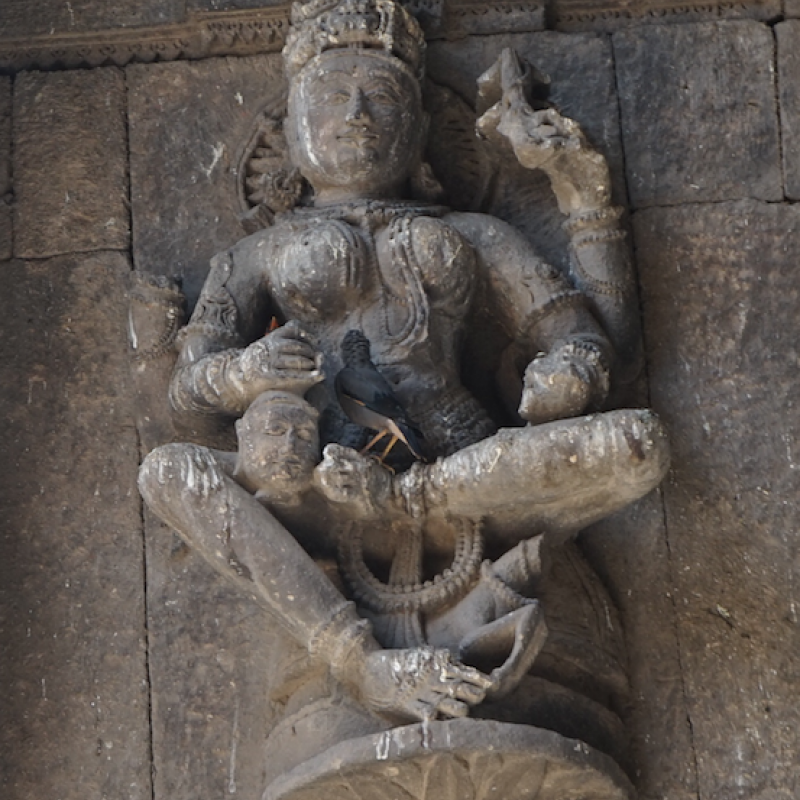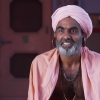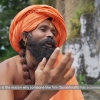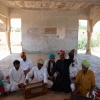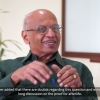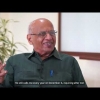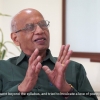'Dabhoi Deity'; Mahudi Gate at Dabhoi in Gujarat. The gate was decorated c. 1220-1230 with depictions of various siddhas, gods and yogis, and includes what we believe to be the oldest known depictions of complex yoga postures. (Photo courtesy: Dr Mallinson and Dr Bevilacqua, March 2016, Haṭha Yoga Project)
There are many varied but overlapping conceptions of the body in India. Each offer different accounts of the body, its function and purpose. There is the medical body, the āyurvedic body, the wrestler’s body, the subtle body and the yogic body. This entry was initially titled the subtle body (sūkṣma śarīra) but reoriented to the yogic body as, despite overlays in terminology and thought, the yogic body is distinct from the sūkṣma śarīra. This entry will define the yogic body, describe its characteristics, summarise the techniques and purposes of manipulating the yogic body and historically contextualise the perceptions and misperceptions of the yogic body.
The yogic body describes the relationship between the physical, ‘real’ body of flesh and blood, the psychical realms of consciousness, and the ritualistic leveraging of these connections. The body of the practitioner is doctrinally and ritually ‘written on’ (Flood 2006). As developed by the Indian tradition, yogic bodies offer a sophisticated and practical account of the realm and relationship between body and mind (Samuel and Johnston 2013). They are purposeful, describing an energetic map to be manipulated for the purposes of power, longevity and liberation. There are, in fact, a range of yogic bodies described across time and traditions—some complementary, some contradictory.
The yogic body is a network of conduits or channels through which ‘substances’ (whether ontologically real, energetic or ritually imagined) travel. This network converges at vortices or cakras structured along the central axis of the body from the base of the torso to the crown of the head or above. Texts on haṭha yoga describe techniques to manipulate this system for different goals. These techniques include mudrā (seal), bandha (binding or lock), āsana (posture), prāṇāyāma (breath control) and mantra (oral formulations whether audible or internalised). The goals include siddhis or vibhūtis (power) or liberation from the round of rebirth (saṃsāra) conceived as mokṣa, mukti, kaivalya or nirvāṇa.
The textual history of the yogic body has nascent beginnings in the Vedas and Upaniṣads in the millennium before the Common Era, becoming developed within tantric texts in the 8th and 9th centuries of the Common Era. Texts that describe haṭha yoga from the 10th century onwards introduce more complex methods of manipulating the yogic body and express an increasingly corporeal understanding of it. Modern understandings of the yogic body are significantly interwoven both with Advaita Vedānta and Western trends and schools of thought including Theosophy, psychoanalysis and New Age spirituality.
There are a number of Sanskrit terms that characterise the yogic body. The ‘structure’ of the yogic body is comprised of nāḍī, cakra, granthi and ādhāra. The ‘substances’ which flow through this ‘map’ include vāyu, prāṇā, amṛta and bindu and kuṇḍalinī.
The nāḍīs are a network of subtle channels carrying vital energy. The number of nāḍīs ranges from two to 32, in early tantric texts including the Niśvāsatattvasamhitā and the Hevajratantra, 101 in the 3rd century BCE Kaṭha Upaniṣad and the familiar 72,000 found for example in the Bṛhadāraṇyaka Upaniṣad (7th to 5th century BCE) and the Vaśiṣṭhasaṃhitā (13th century). While the 72,000 figure is now the most widely accepted, higher numbers are found for example in the 14th–century Śivasaṃhitā which gives 350,000 nāḍīs and the 6th to 10th–century Netratantra’s 35,072,000.
Kaṭha Upaniṣad’s early statement on the nāḍīs identifies one principle nāḍī and a soteriological objective: ‘There are 101 channels (nāḍīs) of the heart. One of them flows to the head. Going upwards by means of it, one reaches immortality. The others spread up and out in all directions’ (Mallinson and Singleton 2017: 187). The predominant model of the yogic body has the central channel as suṣumnā nāḍī which traverses upwards from the base of the torso to the head or above the crown of the head. Suṣumnā is usually flanked by Iḍā and Piṅgalā nāḍīs. The earliest such account is from around the 5th or 6th century’s Vīṇāśikhatantra. The 13th century Vasiṣṭhasaṃhitā describes Iḍā and Piṅgala in relation to suṣumnā in verses 27–30: ‘Iḍā and Piṅgalā are on her left and right. Iḍā is situated to her left and Piṅgalā on the right. The moon and sun move in Iḍā and Piṅgalā. Know the moon to be in Iḍā; the sun is said to be in Piṅgalā. The moon is said to have a predominance of the tamas guṇa, and the sun of rajas; it is these two that cause time, with its days and nights. Suṣumnā consumes time: this that has been taught is a secret’ (2017: 195). This description references esoteric analogies of the sun and the moon, creation and the voiding of creation.
The nāḍīs are described as originating from a ‘bulb’ or kanda, another important site in yogic physiology, located at the bottom of the navel in the Sārdhatriśatikālottara. This idea is widespread in later yoga texts (Mallinson and Singleton 2017: 173). Kuṇḍalinī, see below, is said to be located around the edges of this kanda (Pādmasaṃhitā 2.13c–16). The Śivasaṃhitā describes the kanda (5.77–8), ‘Two fingers above the anus and one finger below the penis is a single flat bulb four fingers across. Facing backwards in the space between the anus and the penis is the Yoni. In it is said to be the bulb (kanda). Kuṇḍalinī resides there at all times’ (208).
The cakras (wheels) or padmas (lotuses) are ‘psychophysical centres’ (Mallinson and Singleton 2017: 171) linked by the nāḍīs. These wheels or vortices are arranged one above the other along the central channel. They vary in number according to different accounts but from the 12th century, there are generally considered to be six. The root or base cakra is mūlādhāra at the perineum, svādhiṣṭhāna at the genitals, maṇipūraka (jewelled city) at the navel, anāhata at the heart, viśuddha at the throat, and ājñā between the eyes or the ‘third eye’—above the eyebrows, at the centre of the forehead. The systems which have a seventh cakra posit the sahasrāra, the thousand-petalled lotus, at the brahmarandhra, the fontanelle at the top of the skull through which the yogi’s vital principle exits at death or the daśamadvāra (10th door) at the top of suṣumnā (2017: 177–8). Sometimes the sahasrāra is beyond the body, such as in the Śivasamhitā.
Each cakra has associated bījamantras (seed syllables), devas (divinities) and illustrations. Cakras are usually represented by lotuses (padmas) with varying numbers of petals and colours. The yogi is to raise their energy along suṣumnā to each cakra from the root upwards. Modern conceptions of cakras, as filtered through Western psychology, have associations with psychological malfunctions when they are energetically or subconsciously, to use Freudian terminology, blocked.
While modern yoga focusses on the cakras as the most important sites in the yogic body, premodern texts on yoga discuss a variety of locations: granthis, ādhāras, marmans and sthānas. Granthis are knots or difficulties. In the yogic body they are three: Brahma granthi at the base of the body, Viṣṇu granthi at the navel and Rudra granthi at the forehead. These granthis are the knots that tie the ‘soul’ to the body. Kaṭha Upaniṣad (6.15) gives the result of breaking the granthi at the heart: ‘When all the knots of/ The heart are broken,/ Mortal becomes immortal:/ This is the teaching’ (Roebuck 2000). Ādhāras are supports for focussing attention. Like the cakras, ādhāras are ‘parts of a visualized installation on the body of tradition-specific metaphysics and ritual schemata’ (Mallinson and Singleton 2017). Marmans are vital points through which the yogi is directed to raise the breath. In Vimānārcanākalpa (verse 97), there are 18: ‘Big toe, ankle, middle of the shank, root of the shin (citimūla), knee, middle of the thigh, anus, middle of the body, penis, navel, heart, throat, root of the palate, bridge of the nose, the region of the eyes, the space between the eyebrows, forehead [and] crown’ (2017: 190). Sthānas are places to stay or abide. In the Bhāgavatapurāṇa, six sthānas are iterated through which to raise the breath, the locations of which are similar to the cakras.
The physiologically and ritually constructed locations of the yogic body are homologised onto locations in the world, cosmos, heaven and hell realms. These connections between the body as microcosm and universe as macrocosm serve as maps or occult diagrams (maṇḍalas and yantras) that may be leveraged by the yogi for power and liberation (White 2001).
That which flows through the nexuses and conduits of cakras and nāḍīs is variously described as vāyu, prāṇa, soul or consciousness, amṛta and bindu, and kuṇḍalinī. Vāyu is wind, and Upaniṣadic conceptions of the nāḍis appear to have combined medical descriptions of veins carrying blood with winds pushing food and fluids through channels (Mallinson and Singleton 2017: 488n8). Yogic conceptions of vāyu become subtler and posit prāṇa as the most important. Concepts of prāṇa are attested in the Ṛg Veda (1.65.10.2) and in Pātañjalayogaśāstra (3.39), winds are first taught in a yogic context (2017: 173). The sūtra text references udāna in relation to the development of siddhis and yogic suicide (utkrānti). The commentary (bhāṣya) elaborates:
Life is activity of all the sense organs, characterized by [the flow of] prāṇa and the other [winds]. Life’s actions are fivefold. Prāṇa flows through the mouth and nose [and] is active as far as the heart. Samāna [is so called] because it carries [nourishment] equally [through the body]; it is active as far as the navel. Apāna [is so called] because it carries away [food, drink, faeces, urine and semen]; it is active as far as the soles of the feet. Udāna [is so called] because it carries [bodily fluids] upwards; it is active up to the head. Vyāna is so called because it pervades [the body]. The most important of these is prāṇa (2017: 191).
Prāṇa is the wind which animates and without which life cannot be sustained. Yogic conceptions of the animating ‘substance’ also include terms that are more related to soul: kṣetrin (soul), haṃsa (goose or swan, a frequent metaphor for the soul) and jīva (the individual soul).
The yogic body often incorporates conceptions of a psycho-spiritual ‘substance’, whether amṛta or bindu (or amṛta-bindu) which is to be preserved, raised and sometimes consumed by the yogi. Amṛta is the nectar of immortality. Bindu means drop and may refer to a drop of amṛta, or physical semen, or semen as a psycho-spiritual substance which animates the yogic body; according to texts such as Amṛtasiddhi, it is the essence of everything. Bindu and amṛta are created or stored within the cranial vault and are associated with the moon. The moon has connotations of the soul or consciousness.
The final metaphysical conception which animates the yogic body is Kuṇḍalinī. The goddess Kuṇḍalinī, ‘she who is coiled’, is śakti, feminine divine creative energy which lies dormant at the root of the spine. The awakening and raising of Kuṇḍalinī is the purpose of yoga practice. The Gorakṣaśataka’s description of Kuṇḍalinī in verses 74–86 draws together many of the aspects of the yogic body discussed above and describes them in dynamic interplay:
The mind is absorbed into the Suṣumnā and the breath does not rush forth. As a result of his secretions being dried up, the yogi’s journey is set in motion. He should force the downward moving apāna breath to move upwards by means of contraction. Yogis call this the root lock (mūlabandha). When the apāna has turned upwards and goes together with fire to the place of prāṇa, then – now that fire, prāṇa and apāna have quickly come together – the coiled, sleeping Kuṇḍalinī, heated by that fire and stimulated by the breath, makes her body enter the mouth of Suṣumnā. Then, having pierced the knot of Brahma, which is born of the quality of passion (rajas), she quickly flashes like a streak of lightning in the mouth of Suṣumnā. She hurries up to the knot of Viṣṇu and, after stopping at the heart, with great speed she moves on, having pierced the knot of Viṣṇu, and goes to where the knot of Rudra is found, between the eyebrows, having pierced which she goes to the orb of the moon, the cakra called Anāhata, which has sixteen petals. Once there, she automatically dries up the fluid produced from the moon.
When the sun has been moved from its abode to the place of blood and bile by the force of prāṇa, Kuṇḍalinī, having gone to where the cakra of the moon is found, which consists of the white fluid of phlegm, consumes there the heated phlegm which has been discharged and is by nature cold. In the same way the white image of the moon is heated forcefully; agitated, Kuṇḍalinī moves upward and thus [the fluid] flows even more. As a result of tasting this, the mind is barred from the objects of the senses. Having enjoyed the best of what is inside him, one [becomes] intent on the self. And Kuṇḍalinī goes to the place which takes the form of the eight constituents of nature. Having embraced it, she moves on to Śiva, after embracing whom she disappears (Mallinson and Singleton 2017).
The dissolution of Kuṇḍalinī here is liberation. In other accounts, such as Khecarīvidyā (3.13), she accesses the amṛta-bindu and, ‘sprinkling the body of the yogi from the soles of his feet to his head with the dewy, unctuous, cool nectar’ (2017: 214) returns to her home at the base.
In this extract on Kuṇḍalinī from Gorakṣaśataka, the technique that initiates this process is mūlabandha, the root lock. Yoga texts recommend a range of techniques for manipulating the yogic body, from meditative visualisations and fixing the breath at the various locations, to physically robust exercises such as pulling on the tongue to stimulate Kuṇḍalinī (the stimulation of Saraswatī in Gorakṣaśataka 16–28) (Mallinson 2012; Mallinson and Singleton 2017). Locks such as mūlabanda and mudrās (seals) are common haṭha yoga techniques, alongside cleansing practices (kriyās), prāṇāyāmas (breathing exercises) and āsanas (postures).
Historical contextualisation: Perceptions and misperceptions
Absent so far from this account of the yogic body has been a discussion of sūkṣma śarīra and kośas. Current popular conceptions of the yogic body usually include that of the sūkṣma śarīra or subtle body conceived as five sheaths or kośas. These are the annamayakośa (food sheath), prāṇamayakośa, manomayakośa (mind sheath), vijñānamayakośa (discernment sheath) and ānandamayakośa (bliss sheath). This scheme is set out in the Taittirīya Upaniṣad (2.1–5) but does not feature in any texts on yoga until some oblique references in 17th century haṭha yoga texts. It is likely that as Advaita Vedānta became the philosophy par excellence of India (Flood 1996) the ‘Upaniṣadic model of the body was grafted on to – or displaced – other, more commonly accepted conceptions of the yogic body’ (Mallinson and Singleton 2017: 184).
Western esotericism in the form of theosophy in the 19th century; Jungian psychoanalysis in the 20th century combined with the popularity of empirical, medical, ‘rational’ and scientific discourses; and the New Age spirituality of the 1960s onwards have significantly shaped (or disparaged) notions of the yogic body.
References
Flood, G. 2006. The Tantric Body: The Secret Tradition of Hindu Religion. London: I.B.Tauris.
———. 1996. An Introduction to Hinduism. New York: Cambridge University Press.
Harper, K.A., and R.L. Brown, eds. 2002. The Roots of Tantra. New York: SUNY Press.
Mallinson, J. 2012. 'The Original Gorakṣaśataka.' In Yoga in Practice, edited by David Gordon White. Princeton: Princeton University Press.
Mallinson, J., and M. Singleton. 2017. Roots of Yoga. London: Penguin.
Roebuck, V. 2000. The Upanishads. London: Penguin.
Samuel, G., and J. Johnston. 2013. Religion and the Subtle Body in Asia and the West: Between Mind and Body. Routledge.
White, D.G. 2001. Tantra in Practice. Delhi: Motilal Banarsidass.
